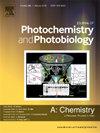Donor–π bridge-acceptor dyes featuring dual chromophoric groups for enhanced sensitivity in wearable sweat sensor
IF 4.1
3区 化学
Q2 CHEMISTRY, PHYSICAL
Journal of Photochemistry and Photobiology A-chemistry
Pub Date : 2024-10-20
DOI:10.1016/j.jphotochem.2024.116090
引用次数: 0
Abstract
The pH value of human sweat serves as a crucial biomarker for disease diagnosis, rendering wearable sweat sensors an innovative tool for monitoring human health. However, the commercialization of these devices is seriously impeded by their low sensitivity, poor wearing comfort, and limited reusability. In this work, a reactive dye capable of color change under pH change has been synthesized. Due to the unique molecular structure, the dye molecule exhibits remarkable color change recognition and high sensitivity. To fabricate a wearable pH sensor, screen printing technology was employed for depositing the color-changing dye onto cotton fabric. The resulting sensor demonstrated excellent performance attributes including high color sensitivity, robust cyclic stability in response to pH changes, and exceptional resistance against washing, friction, and sunlight-induced fading. Therefore, this study presents a highly promising approach for achieving real-time monitoring of human sweat pH levels.

具有双重发色基团的供体-π 桥-受体染料可提高可穿戴式汗液传感器的灵敏度
人体汗液的 pH 值是诊断疾病的重要生物标志物,因此可穿戴汗液传感器成为监测人体健康的创新工具。然而,这些设备灵敏度低、佩戴舒适度差、可重复使用性有限,严重阻碍了其商业化。在这项工作中,我们合成了一种在 pH 值变化时能够变色的活性染料。由于其独特的分子结构,该染料分子具有显著的颜色变化识别能力和高灵敏度。为了制作可穿戴的 pH 传感器,采用了丝网印刷技术将变色染料沉积到棉织物上。制得的传感器表现出卓越的性能属性,包括高色彩灵敏度、对 pH 值变化的强周期稳定性以及优异的耐洗涤、耐摩擦和耐日光褪色性能。因此,这项研究为实现人体汗液 pH 值的实时监测提供了一种极具前景的方法。
本文章由计算机程序翻译,如有差异,请以英文原文为准。
求助全文
约1分钟内获得全文
求助全文
来源期刊
CiteScore
7.90
自引率
7.00%
发文量
580
审稿时长
48 days
期刊介绍:
JPPA publishes the results of fundamental studies on all aspects of chemical phenomena induced by interactions between light and molecules/matter of all kinds.
All systems capable of being described at the molecular or integrated multimolecular level are appropriate for the journal. This includes all molecular chemical species as well as biomolecular, supramolecular, polymer and other macromolecular systems, as well as solid state photochemistry. In addition, the journal publishes studies of semiconductor and other photoactive organic and inorganic materials, photocatalysis (organic, inorganic, supramolecular and superconductor).
The scope includes condensed and gas phase photochemistry, as well as synchrotron radiation chemistry. A broad range of processes and techniques in photochemistry are covered such as light induced energy, electron and proton transfer; nonlinear photochemical behavior; mechanistic investigation of photochemical reactions and identification of the products of photochemical reactions; quantum yield determinations and measurements of rate constants for primary and secondary photochemical processes; steady-state and time-resolved emission, ultrafast spectroscopic methods, single molecule spectroscopy, time resolved X-ray diffraction, luminescence microscopy, and scattering spectroscopy applied to photochemistry. Papers in emerging and applied areas such as luminescent sensors, electroluminescence, solar energy conversion, atmospheric photochemistry, environmental remediation, and related photocatalytic chemistry are also welcome.

 求助内容:
求助内容: 应助结果提醒方式:
应助结果提醒方式:


